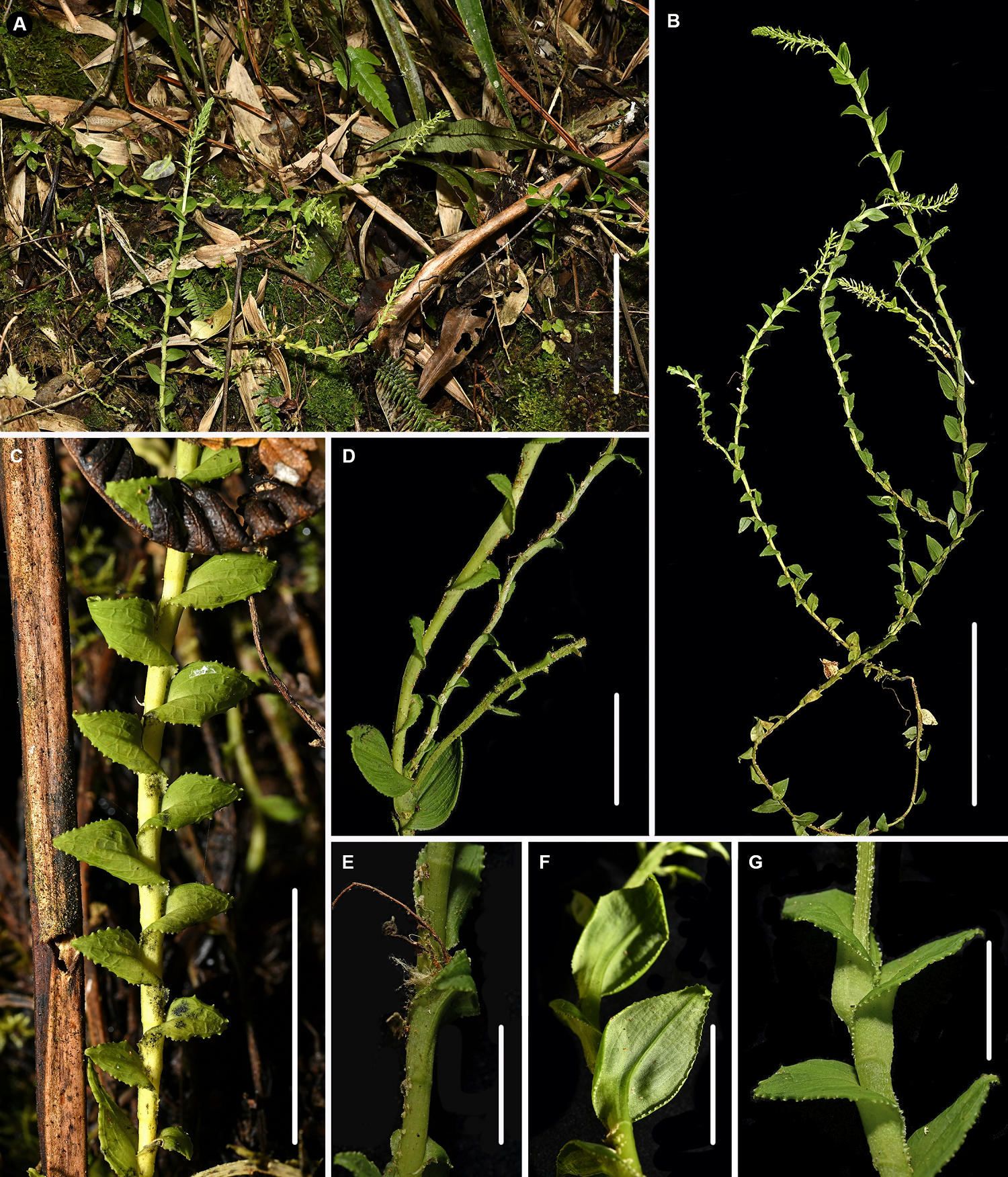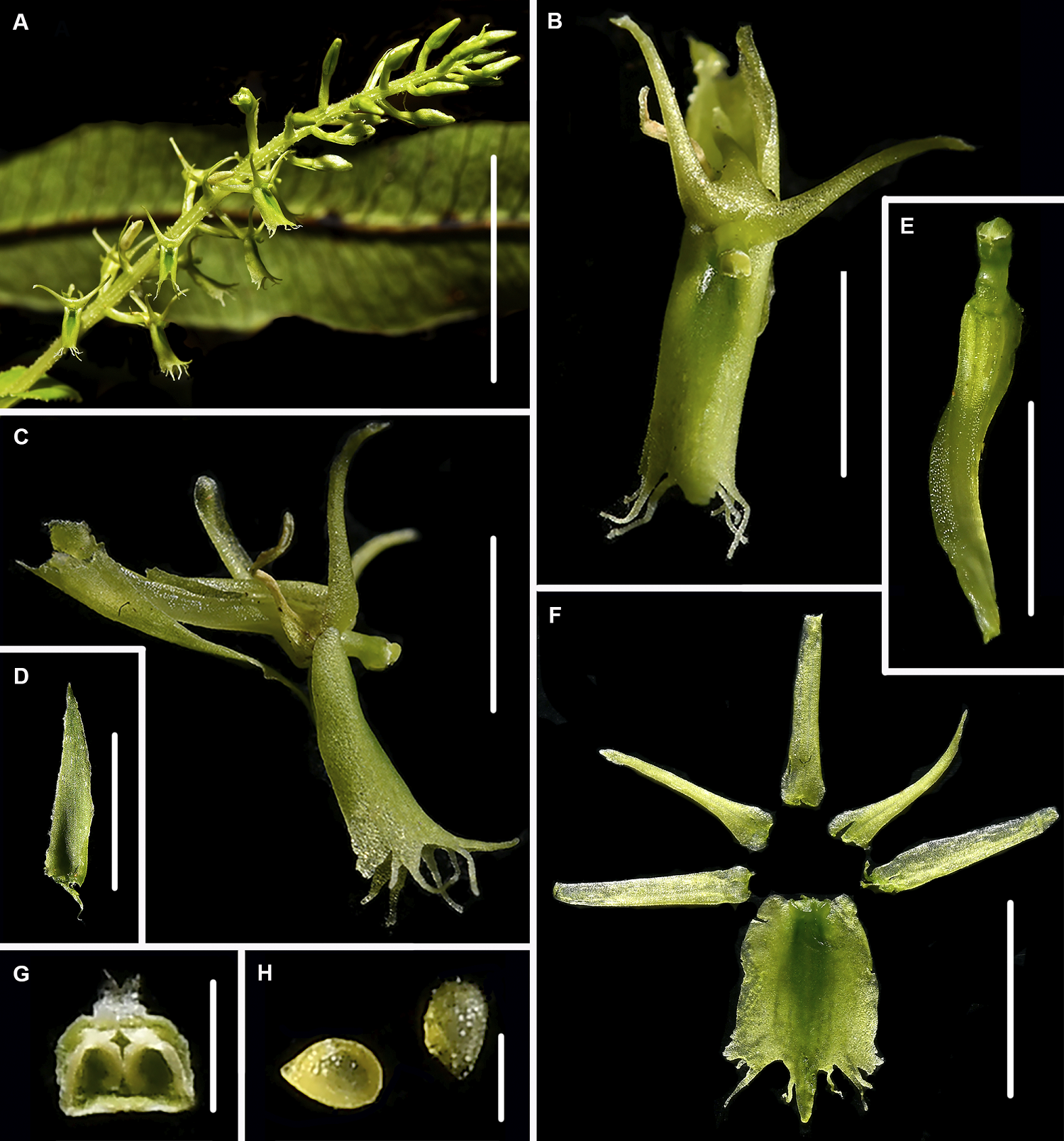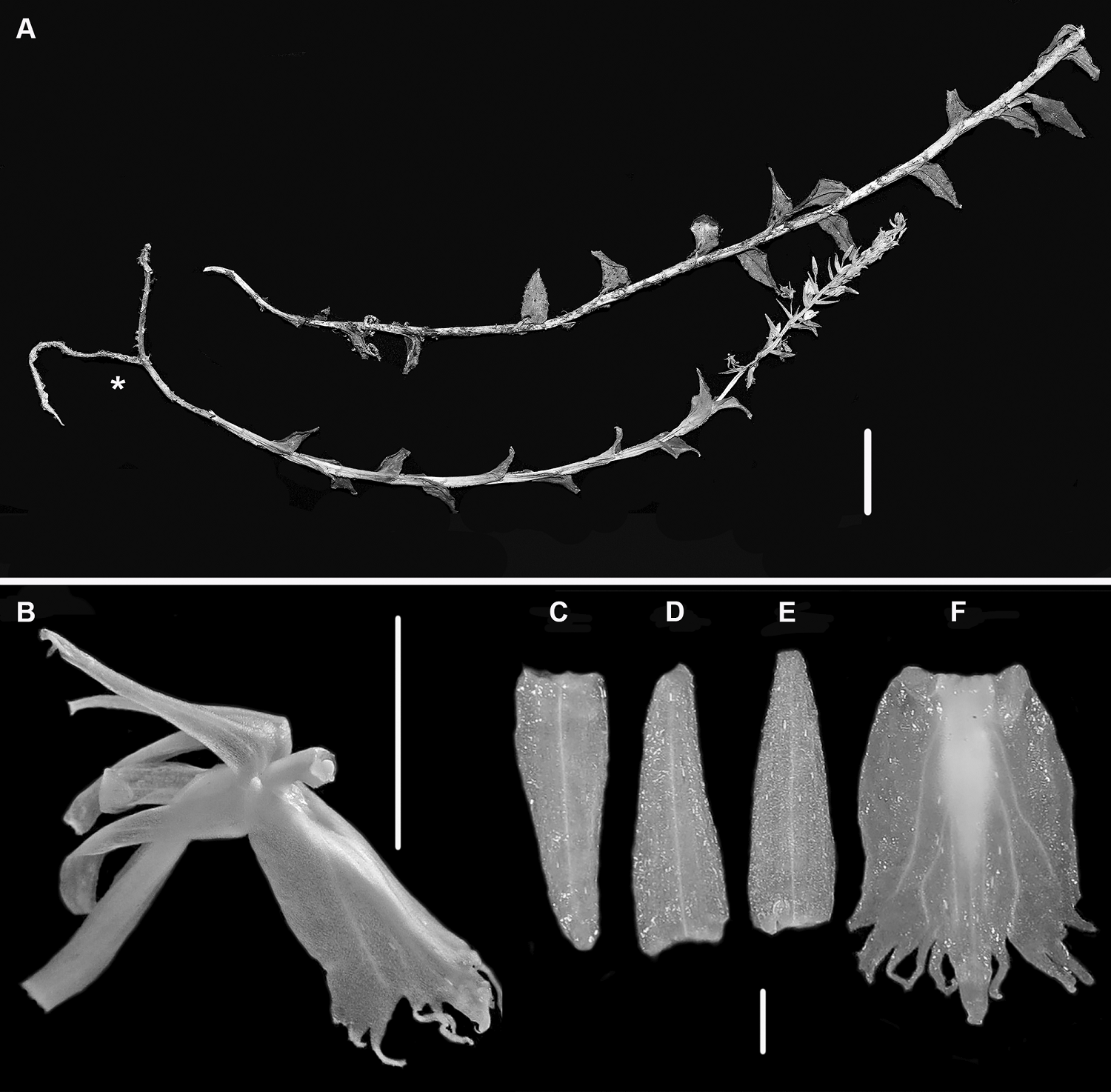Liparis Rich. is a cosmopolitan genus encompassing ca. 320 species, distinguished from other Malaxidinae by an elongate, arcuate column with incumbent anther (Ridley 1886, Cribb et al. 2005). Although Liparis in the broad sense is polyphyletic (Cameron 2005), only a fraction of its species diversity has been included in molecular phylogenetic analyses, with a bias towards Old World groups (e.g.,Tang et al. 2015, Li et al. 2020). Much work remains to be done to achieve a thorough systematic revision of the genus and its limits, but in the meantime the morphology-based sectional classification of Liparis by Garay & Romero-González (1999) provides a useful framework for comparison and taxonomic discussion of morphologically discrete groups within the genus. One of the most distinctive groups of Liparis in the Neotropics is L. sect. Decumbentes Garay & G.A.Romero, which consists of four species characterized by their decumbent, creeping long stems with distichously arranged leaves (Garay & Romero-González 1999, Damián et al. 2020; Figure 1). All known species of sect. Decumbentes are restricted to wet Andean montane forests and have quite localized populations; they are only rarely collected and remain as one of the lesser-known Neotropical orchids.

Figure 1 Liparis inaudita (from Edquén 1937). A. Plant in situ. B. Plant removed from the ground showing the branching stems. C. Portion of stem with leaves, top view. D. Portion of stem with three branches arising from a leaf axil, top view. E. Portion of stem with clumps of white trichomes. F. Underside of leaves showing the decurved, crispate margins. G. Stem apex and base of the peduncle of the inflorescence showing the irregularly dentate-crenate keels of the peduncle. Bars: A, B = 10 cm, C = 5 cm, D-G = 2.5 cm. Photographs by José D. Edquén.
Schweinfurth (1959) recorded two species attributable to sect. Decumbentes in his inventory of the orchid flora of Peru, namely L. crispifolia Rchb.f. and L. laticuneata C.Schweinf., and subsequent lists of Peruvian orchids by Brako & Zarucchi (1993) and Zelenko & Bermúdez (2009) followed suit. Recently, Goicochea et al. (2019) added L. brachystalix Rchb.f. based on specimens listed in the Tropicos.org page of the Missouri Botanical Garden (www.tropicos.org; A. Goicochea pers. comm. 2019). Damián et al. (2020) described a new Peruvian species belonging to this section, L. sessilis Damián, Salazar & Rimarachín, arguing for the exclusion of L. crispifolia from the Peruvian flora in the absence of specimens supporting its presence in the country, and provided an identification key to the four species they accepted in the section.
During a field trip conducted as part of our ongoing inventory of the orchid flora of the Bosque de Protección Alto Mayo, in northern Peru (J.D. Edquén et al., unpubl. data), an additional, unknown species of L. sect. Decumbentes was discovered. Its comparison with previously known species revealed similarities to L. sessilis in the sessile leaf blades and convex labellum, but the new entity differs from it, and all other members of this section, in its unique labellum morphology (Figures 2, 3). We provide a description and photographic documentation of its vegetative and floral features, highlight the characters that distinguish it from its relatives, and provide an updated identification key for L. sect. Decumbentes.

Figure 2 Liparis inaudita (from Edquén 1937). A. Inflorescence. B. Flower, front view. C. Flower, side view. D. Floral bract. E. Ovary and column, bottom view. F. Dissection of the perianth with sepals and petals partially spread out. G. Anther, bottom view. H. Pollinaria, side view. Bars: A = 3 cm, B, C = 4 mm, D, F = 5 mm, E = 3 mm, G = 0.5 mm, H = 0.3 mm. Photographs by José D. Edquén.

Figure 3 Liparis inaudita (from Edquén 1937). A. Pressed specimen showing a single root near the stem base (marked by a *). B. Alcohol-preserved flower, side view. C-F. Spread out floral segments of an alcohol-preserved flower. C. Lateral sepal. D. Petal. E. Dorsal sepal. F. Labellum. Bars: A = 2.5 cm; B = 4 mm, C-F = 1 mm. Photographs by José D. Edquén (A) and Delsy Trujillo (B-F).
The Bosque de Protección Alto Mayo (BPAM) encompasses 182,000 ha of rugged mountainous terrain on the eastern (Amazonian) slope of the Andes in the northwestern portion of the Department of San Martin and adjacent areas of the Departments of Amazonas and Loreto (approximate coordinates: 5.4° - 6.2° S, 77.2 - 77.8° W), in an elevational range from ~ 900 to 3,700 m asl. According to the eco-regionalization of Peru by Britto (2017), the vegetation consists of wet lower montane forest (“bosque muy húmedo montano bajo”) in the foothills, montane rain forest (“bosque pluvial montano”) from ~ 2,500 m asl, and high-elevation grassland (“jalca”) above ~ 3,200 m asl. The BPAM was established in 1987 by the Peruvian government to protect the water sources for agriculture, industrial use, and human consumption in the valley of the Upper Mayo River, as well as to conserve the fauna and flora (SERNANP continuously updated). The area has not been fully inventoried floristically, but a preliminary survey revealed high plant diversity (Dillon & Sánchez Vega 2001), and subsequent studies have found new species of trees (Dillon & Sánchez Vega 2009) and orchids (Acuña-Tarazona et al. 2019, Hágsater et al. 2019, 2020).
Materials and methods
Plants were photographed in situ with a digital camera (Nikon 850, Nikon Corporation, Tokyo, Japan) provided with a 60 mm AF Micro Nikkor lens (Nikon). Image processing and plate preparation was carried out with Adobe Photoshop v.22.4.2. Specimens were pressed to serve as the holotype, deposited in the herbarium of the Museo de Historia Natural, Universidad Nacional Mayor de San Marcos, Lima, Peru (USM), and two isotypes to be distributed to HOXA and KUELAP. Flowers preserved in 70 % ethanol were examined and photographed under a stereomicroscope. Measurements were made on the pressed specimens and the alcohol-preserved flowers. The pertinent literature was revised, including the protologues of all previously described species of Liparis sect. Decumbentes, floristic treatments, and other works that include descriptions or illustrations of this group (e.g.,Foldats 1969, Vázquez & Dodson 1982, Dodson & Dodson 1984, Dodson 2002, Zelenko & Bermúdez 2009, Damián et al. 2020). Type specimens were examined and additional specimens of Neotropical Liparis were studied in the herbaria AMES, AMO, GH, HOXA, K, KUELAP, MEXU, MO, MOL, NY, QCE, QCNE, UFV, US, and USM.
Results
Liparis inaudita Salazar, Edquén et D.Trujillo, sp. nov.
Type: Peru. Departamento San Martín, provincia Rioja, distrito Pardo Miguel Naranjos, Bosque de Protección Alto Mayo, sector Venceremos, 1828 m, bosque montano bajo, hierba terrestre postrada de 40 a 60 cm de largo, flores verde claro, 1 Mar 2020, J. D. Edquén 1937 (holotype: USM!, isotypes HOXA, KUELAP).
Diagnosis. Similar to Liparis sessilis Damián, Salazar & Rimarachín in the sessile leaf blades but differing from that and all other species of the sect. Decumbentes in the saddle-shaped, narrowly obtrapezoid labellum with minute basal auricles, laciniate distal margins, and prominent, narrowly triangular apical lobule.
Morphological description. Terrestrial, decumbent, creeping herb 40-120 cm long (Figures 1A, B). Roots to 5 cm long, 1-1.5 mm in diameter, scarce, produced singly from nodes of the stem in the part of the plant in contact with the ground, terete, dull white (Figure 3A). Stems 15-70 cm long, 2-2.5 mm wide, slightly compressed, sparingly branching, with sparse clumps 1-3 mm in diameter of white, short trichomes of unknown function (Figure 1D, E). Leaves distichously arranged along the stems, base conduplicate, sheathing the stem, 3-5 × ca. 2 mm, blade 9-15 × 8-15 mm, sessile, ovate-elliptic, its upper surface medium dark green with prominent, reticulate veins, underside pale grayish-green, margins deflexed, crispate, apex acute (Figures 1C, F, G). Inflorescence 6.5-8 cm long, terminal, racemose, ascending; peduncle 1.5-2 cm long, 2 mm in diameter, subterete, with several longitudinal, sparsely and irregularly denticulate-crenate keels (Figure 1G); raceme at least 5-6 cm long (not seen with all flowers open), with 25-40 flowers opening in succession, rachis ornamented as the peduncle (Figure 2A). Floral bracts 6.5-7.5 mm long, 2-2.5 mm wide near the base, green, conspicuously longer than the ovary, narrowly triangular to triangular-lanceolate, acuminate, margins sparsely and irregularly denticulate (Figure 2D). Flowers resupinate, pale green with the column and the central part of the labellum darker green (Figures 2B, C). Ovary ca. 5 × 0.8 mm, terete, 3-costate, slightly twisted, incurved above the middle (Figures 2E, 3B). Dorsal sepal 4.5-5 × 1.4 mm, strongly reflexed from the base, slightly convex, lanceolate, obtuse-rounded, 1-veined (Figure 3E). Lateral sepals 4.5-5 × 1.5 mm, strongly reflexed from the base, slightly convex, obliquely lanceolate, rounded, 1-veined (Figure 3C). Petals 4.5-5 × 1.2-1.5 mm, spreading, slightly incurved, convex, obliquely triangular-lanceolate, rounded, 1-veined (Figure 3D). Labellum 5.8 mm total length, 3.5 mm wide near the middle, in natural position spreading at an acute angle from the column, saddle-shaped because of its downcurved margins, when spread out narrowly obtrapezoid, obscurely auriculate at each side of the base (auricles retrorse, broadly triangular, obtuse-rounded, ca. 0.25 mm long), lateral margins gently curved outwards, distal margins irregularly laciniate, apex extended into a narrowly triangular, rounded lobule, apical lobule ca. 1.2 × 0.7 mm; 5-veined, the veins next to the central one bifurcating below the middle (Figures 2F, 3F). Column ca. 1 × 0.5 mm, clavate, slightly incurved; stigma ventral, slightly concave, subrectangular (Figure 2E). Anther ca. 0.5 × 0.6 mm, terminal, incumbent, semiglobose, two-celled (Figure 2G). Pollinaria 2, ca. 0.3 × 0.2 mm, semiovoid, translucent yellow, each united at apex to a drop-like viscidium (Figure 2H). Capsule not seen.
Distribution and ecology. Known from a single population located in the Sector Venceremos, northwestern part of the BPAM. Creeping terrestrial, in leaf mold and on fallen, rotting tree trunks on a steep slope with lower montane cloud forest dominated by low trees of Weinmannia sp. and Polylepis sp., with Chusquea sp. in the understory, at around 1,830 m elevation.
Phenology. Flowering in February and March, but the numerous flower buds observed suggest that flowering might continue at least into April. Fruits were not observed.
Conservation status. Despite having trekked more than 40 km over several days in that portion of the BPAM, only a single population of this species was found, and it had not been recorded during our several previous collecting trips to other parts of the protected area. The single population of L. inaudita consists of about 70 individual stems or clumps of stems on a few square meters. The creeping, branching nature of the stems did not permit us to ascertain whether such clumps may represent clones resulting from vegetative expansion and fragmentation, or different genetic individuals. Thus, L. inaudita seems to be a rare plant, but vast expanses of potentially suitable habitat remain to be explored and it is probable that further field work will result in the discovery of additional populations, as has occurred with other rare BPAM species such as Magnolia bankardiorum M.O.Dillon & Sánchez Vega, originally known only from two collections of the BPAM (Dillon & Sánchez Vega 2009), but subsequently recorded elsewhere in Peru and Ecuador (https://www.tropicos.org/home; accessed 13 July 2021). The plants of L. inaudita occur along a trail and trampling is a potential threat, but otherwise there is no information that permits us to carry out an objective assessment of its risk status. We suggest considering it as “Data Deficient”.
Etymology. From Latin inauditus, unheard of, new, in reference to the peculiar morphology of the labellum, which sharply differs from that of all previously known members of Liparis sect. Decumbentes.
Discussion
Liparis inaudita is unique among the Neotropical species of the genus, including all members of sect. Decumbentes, in the saddle-shaped, narrowly obtrapezoid labellum with laciniate distal margins, and prominent, narrowly triangular apical lobule (Figures 2F, 3F). The most similar species is L. sessilis, with which L. inaudita shares the sessile leaf blades, but in L. sessilis the labellum is only slightly convex and, when spread out, ovate-elliptic with irregularly erose distal margins, lacking basal auricles and an apical lobule (see Damián et al. 2020: Figures 1A, 2D).
Key to the species of Liparis sect. Decumbentes.
1. Labellum saddle-shaped, i.e., strongly convex with the lateral margins downcurved, distal margin laciniate, apex projected into a narrowly triangular lobule ………………………………………………………… L. inaudita
1. Labellum not saddle-shaped, at most slightly convex without downcurved margins, slightly concave or strongly recurved, distal margins entire or erose, apex rounded to shallowly emarginate, minutely apiculate or mucronate …………………………………………………………………………………………………………………………………………………… 2
2. Labellum strongly recurved, when spread out abruptly expanded from a short cuneate base, about two times wider than long, transversely oblong-flabellate, apex apiculate …………………………………… L. laticuneata
2. Labellum flat, slightly convex or slightly concave, when spread not abruptly expanded from a short cuneate base, longer than wide, oblong-cuneate, ovate-elliptic, ovate-rhombic, or pandurate, apex obtuse, rounded, or shallowly emarginate and apiculate in the sinus ………………………………………………………………………… 3
3. Leaf blades sessile; labellum slightly convex in natural position, when spread out ovate-elliptic, apex and base rounded ……………………………………………………………………………………………………………………………………… L. sessilis
3. Leaf blades petiolate; labellum flat or slightly concave in natural position, when spread out obovate, pandurate, or ovate-rhombic, apex obtuse or shallowly emarginate, mucronate, base cordate ………………… 4
4. Flowers with pale green sepals and petals, and red purple labellum; labellum ovate-rhombic, obtuse; column slender above a thick base, strongly arcuate, about four times as long as wide or longer ………………………………………………………………………………………………………………………………………………………… L. crispifolia
3. Flowers entirely green with a darker green central stripe on the labellum; labellum obovate or pandurate, shallowly emarginate, the sinus apiculate; column thick throughout, slightly arcuate, about 2.5 times longer than wide …………………………………………………………………………………………………………………………………… L. brachystalix











 nueva página del texto (beta)
nueva página del texto (beta)



